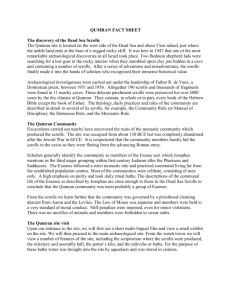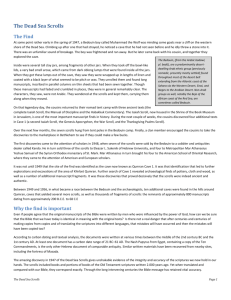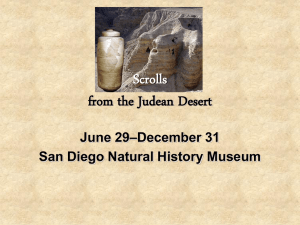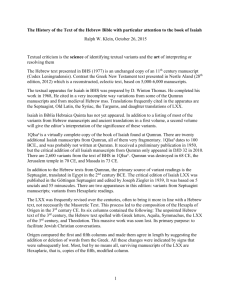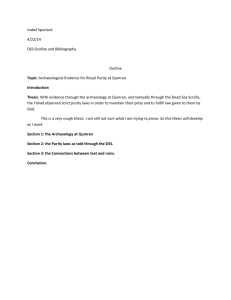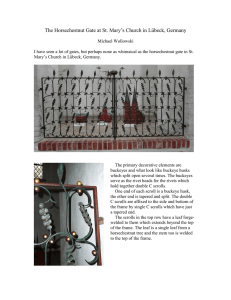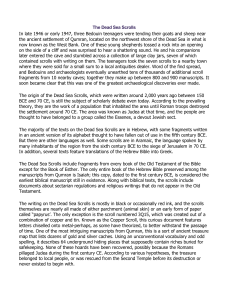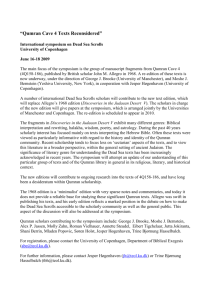Frank Moore Cross: Scholar, Teacher, Mentor
advertisement
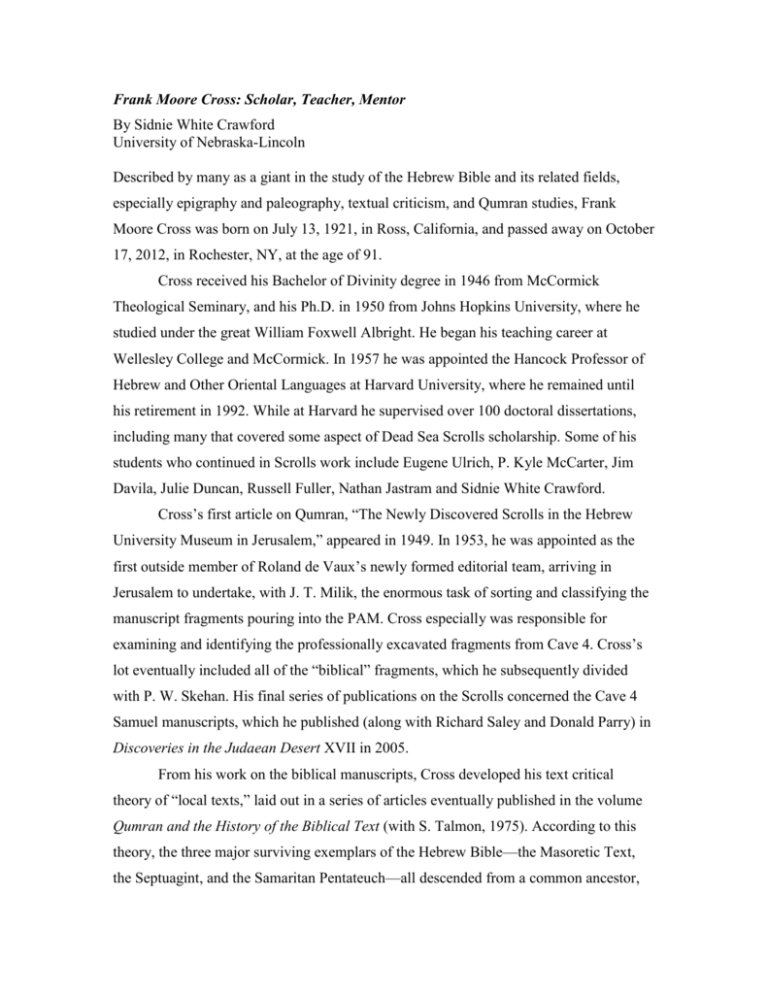
Frank Moore Cross: Scholar, Teacher, Mentor By Sidnie White Crawford University of Nebraska-Lincoln Described by many as a giant in the study of the Hebrew Bible and its related fields, especially epigraphy and paleography, textual criticism, and Qumran studies, Frank Moore Cross was born on July 13, 1921, in Ross, California, and passed away on October 17, 2012, in Rochester, NY, at the age of 91. Cross received his Bachelor of Divinity degree in 1946 from McCormick Theological Seminary, and his Ph.D. in 1950 from Johns Hopkins University, where he studied under the great William Foxwell Albright. He began his teaching career at Wellesley College and McCormick. In 1957 he was appointed the Hancock Professor of Hebrew and Other Oriental Languages at Harvard University, where he remained until his retirement in 1992. While at Harvard he supervised over 100 doctoral dissertations, including many that covered some aspect of Dead Sea Scrolls scholarship. Some of his students who continued in Scrolls work include Eugene Ulrich, P. Kyle McCarter, Jim Davila, Julie Duncan, Russell Fuller, Nathan Jastram and Sidnie White Crawford. Cross’s first article on Qumran, “The Newly Discovered Scrolls in the Hebrew University Museum in Jerusalem,” appeared in 1949. In 1953, he was appointed as the first outside member of Roland de Vaux’s newly formed editorial team, arriving in Jerusalem to undertake, with J. T. Milik, the enormous task of sorting and classifying the manuscript fragments pouring into the PAM. Cross especially was responsible for examining and identifying the professionally excavated fragments from Cave 4. Cross’s lot eventually included all of the “biblical” fragments, which he subsequently divided with P. W. Skehan. His final series of publications on the Scrolls concerned the Cave 4 Samuel manuscripts, which he published (along with Richard Saley and Donald Parry) in Discoveries in the Judaean Desert XVII in 2005. From his work on the biblical manuscripts, Cross developed his text critical theory of “local texts,” laid out in a series of articles eventually published in the volume Qumran and the History of the Biblical Text (with S. Talmon, 1975). According to this theory, the three major surviving exemplars of the Hebrew Bible—the Masoretic Text, the Septuagint, and the Samaritan Pentateuch—all descended from a common ancestor, but evolved in different ways in isolation from one another: the Masoretic Text in Babylon, the Septuagint in Egypt, and the Samaritan Pentateuch in Palestine. Cross always emphasized, however, that the history of each biblical book was different, and the textual history of each book needed to be investigated separately. This theory dominated the early post-Qumran phase of textual criticism, and remains influential today. Cross was also the dominant epigraphist and paleographer working in the United States for fifty years. In his monograph, “The Development of the Jewish Scripts,” he worked out the typological sequence of scripts of the late Second Temple period. His sequence was the template used by all of the editors of the Qumran fragments for their paleographic dating, and continues, with minor adjustments, to be the major resource for all paleographic studies of Second Temple period manuscripts. When fragments of the scrolls were subjected to carbon-14 testing in the 1990s, and the carbon-14 dates matched the paleographic dates Cross had assigned to the manuscripts, he was heard to say, with a twinkle in his eye, that he was delighted that his paleographic studies had verified the accuracy of carbon-14 dating. Finally, Cross also turned his attention to the history and thought of the Qumran community. His early introduction to the Scrolls, The Ancient Library of Qumran and Modern Biblical Scholarship (1958), went through one German and three English editions, the last revised English edition appearing in 1995. In it, Cross presents a readable synthesis of his views on the Scrolls and the Qumran community, including a history of the discovery of the Scrolls and a defense of the Essene hypothesis. Cross was one of the few scholars capable of both the painstaking study of detail and a vision of the larger issues to which the details pertained. His broad and deep knowledge of Hebrew language, Israelite history, the text of the Hebrew Bible, and the archaeology of SyroPalestine was brought to bear on all aspects of his scholarship, and enabled him to set a standard which few scholars today can emulate. Even in the face of his enormous erudition and vast scholarly accomplishments, Frank Moore Cross was a warm and approachable man, unfailingly polite (he was often described as a “southern gentleman”), and generous to colleagues and younger scholars. He was an exacting but caring mentor, expecting much from his students and giving much in return. He was devoted to his family, especially his wife of sixty years, Betty Anne, whose devotion and care, he well realized, made possible his academic career. He mightily enjoyed his visits to Israel, where he formed close friendships with such revered figures as Benjamin Mazar, Nahman Avigad and Chaim Tadmor. He was a devotee of mystery novels, and an avid horticulturalist. He will be greatly missed by all who knew him. Sidnie White Crawford

